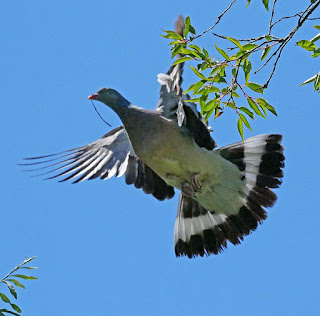They behave quite differently from the wood pigeons on farmland just a mile away, where they are very wary birds. Here in the garden they walk up and down the garden path, ignoring us while we garden, and will only flutter out of the way when we come within a few feet of them. They behave almost like chickens.
They do have a comfortable life here, with bird table food in winter. This one sits under the sunflower seed feeder, picking up seed dropped by visiting finches and coal tits.
The tree is the hub of garden bird activity, with a tangle of pendulous branches and a cool, shady dome of foliage in summer. Tree sparrows occupy the nest box and the wood pigeons have built a flimsy nest platform of twigs directly above.
The nest is about six feet above our heads as we pass underneath, so the mother bird, and the squabs when the eggs hatch, just stare down at us, undisturbed, as we pass below on our way up and down the garden.
The squabs are not the prettiest of fledglings when they leave the nest, and have peculiar soft, pointed beaks, adapted to taking an avian form of mother's milk from the crop of the parent bird, a secretion that is highly nutritious, so the juvenile birds develop quickly.
You can see here how the squab pushes its beak right down into the parent bird's crop to reach that strange, milky secretion.
This is a squab in late May at about three weeks after leaving the next, still partially dependent on its parent but with a beak that's developing for foraging for an independent diet.
The adult diet is mostly vegetable, feeding on leaves, buds and seeds, but in early spring the big event in the birds' dietary calendar is the ripening of ivy berries in the hedge in the front garden. The whole crop disappears over a period of a few days in April.











































No comments:
Post a Comment
Note: Only a member of this blog may post a comment.